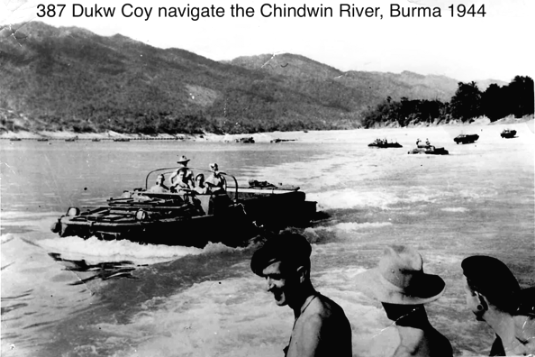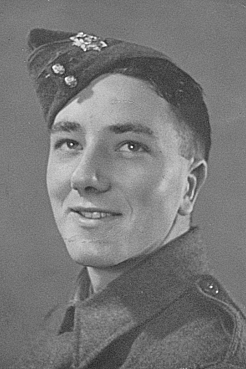The Harry Hopton story told by his daughter Mary Cole
Harry Hopton T282143, 387 Coy, Royal Army Service Corps (Amphibious), 2nd Division, Burma.
By February 1944, Harry, a member of 387 Coy, RASC (amphibious) had been serving in India and Burma for more than 3 years. His company had practiced amphibious landings in and around Bombay during 1942/43. When in March of 1944, 15,000 Japanese soldiers headed for the small hill station of Kohima, Nagaland, Harry, as part of the 2nd Division, were sent to relieve the 1’500 besieged Royal West Kent’s and Assam regiments stuck on the District Commissioner’s bungalow, dug in around a perimeter of a tennis court.
Such was the need for replacements in infantry, over 200 Royal Army Service Corp members, including Harry were used as Infantry, to fill the gaps during the battle which lasted until June 44, Harry had been on attachment with the 1st Battalion Royal Welch Fusiliers before he returned to his amphibious duties on the river Chindwin, upper Burma. Due to the very poor road conditions, most equipment and men had to be towed down the river and, by the end of December 1944, his Coy Duwks had covered 32,000 water miles ferrying between Kalewa and Shwegyn.


After the Chindwin came the push for Mandalay and Meiktila in central Burma (Operation Extended Capital, Slims masterstroke for recapture of central Burma ) and 387 Duwks would be heavily involved.
They made their way down the Chindwin River and onto the west bank of the Irrawaddy river at Myinmu, near the 2nd Division proposed crossing point towards Mandalay.
On the night of the 24/25th February 1945, three landing beaches had been identified on the east bank at Ngazun and Harry, along with his company were told to standby to ferry troops and supplies across the river after the main assault boats had taken the first flight of assault troops across and secured the beachheads.
Zero hour was 10pm, the main assault craft were in place and, the assault across the Irrawaddy was commenced. It was made all the more difficult by a fast running river, floating debris and, a full moon which would not allow them the secrecy they had hoped for. Neither was it a straightforward run across the river due to the proximity of sandbanks mid stream which had to be circumvented and shifting sands which changed the depth of the river at each tide, meaning any craft would be in the water for considerably longer than was ideal under the circumstances.

The first motorboats of the 5th Infantry Brigade set off, but very soon, it became apparent that the strong current was not suitable for the boats and that the three landing areas were more heavily defended than anticipated. Two beaches could not be taken, and a third was covered by a well placed Japanese machine gun.
Each driver made an average of 7 crossings, each crossing under sustained and accurate enemy fire but, despite this, 387 Coy continued to ferry successive flights of troops across the river and managed to maintain the ferry service for over 14 hours whilst the east bank was being secured.
When it was realised that the assault boats could not cope with the river conditions, Harry with 387 were called up by their Commanding Officer, 2nd Lieutenant Clark and were informed that their Duwks were to carry troops for the main assault.
As they started across the river, they came under intense and accurate enemy machine gun fire which peppered the Duwks with holes. Every single Duwk sustained damage and the company plugged the holes with wooden pegs to avoid taking in water.
By early light on the 25th, several Duwks found themselves stranded on a mid stream island and seeing his men stranded, 2nd Lieutenant Clark took to the water in a boat, helped to free the Duwks and find a safe channel through to the east bank landing areas.
For his quick action in gathering his company for the main assault, in ensuring his company Duwks were released from the sandbank/island and, for finding a route through the river, 2nd Lieutenant Clark was awarded the immediate award of the Military Cross and Corporal Sglon, Corporal Lines, Corporal Messe, Driver Hall and Driver O’Brien were awarded the Military Medal.
Despite the bridgeheads being secured, there were still many small groups of Japanese on the east banks of the Irrawaddy willing to fight to the death, and on the 26th February,Driver Harry Bryar was killed whilst crossing. He would later be buried in Rangoon .Following the events of the main assault, 387 Coy continued with a ferry service. Over the period of 72 hours, 387 Coy would ferry over 6000 troops and 250 vehicles across the river.

Harry would then find himself heading for Mandalay alongside the Royal Berkshire Regiment ,and once Mandalay was secured, his company made their way down through central Burma to eventually reach Rangoon on 9th June.
Harry would stay in Rangoon for about 10 days before orders came through to move back to India. The plan would be to head for Bombay and on to Singapore and Hong Kong. However , when they reached Kurla North, Central India, they were told that the Japanese had surrendered.
387 Coy would go on to Singapore and Hong Kong , but Harry, contracted tropical disease, for which there was no cure at that time. Weighing just 7 stone he was placed aboard Bombay moored hospital ship HMHS Somersetshire on 31st October 45 along with 348 sick/wounded and 116 repatriating prisoners of war.
His condition remained critical for many weeks however, after 9 months in Liverpool, Smithdown Road hospital, he was well enough to leave but, was discharged from the army, unfit for further duties.
Harry had served for 4 years, 354 days.
To see more of this aspect of the war visit Daily Motion, the link is here https://www.dailymotion.com/video/x12du8g
